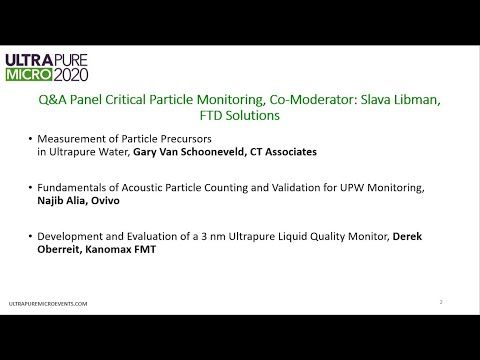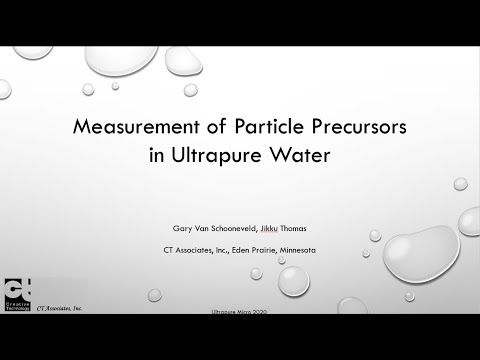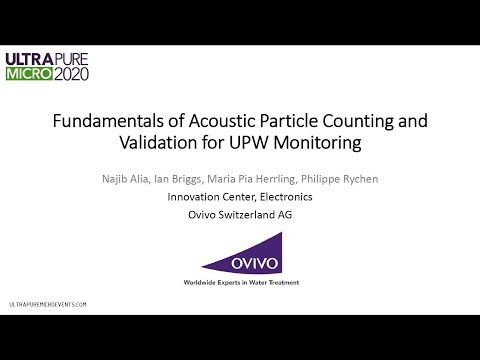
Yana Nazarova
Global Water Intelligence
Collaborators
Tags
Particle PrecursorsNanoparticlesMetrology and Analytical TechnologyCritical Particle Monitoring: Online Q&A
Share this insight
The first UPM virtual event took place on November 9-11, and as usual generated a lot of discussion. We would like to continue these conversations and so have provided the opportunity for you to continue speaker Q&A through the Ultrapure Micro online platform.
The session Critical Particle Monitoring has received a lot of questions, and so we reached out to its speakers to continue the discussion. The session featured 3 presentations :
- Measurement of Particle Precursors in Ultrapure Water - Gary van Schooneveld, CT Associates
- Fundamentals of Acoustic Particle Counting and Validation for UPW Monitoring - Najib Alia, Ovivo
- Development and Evaluation of a 3 nm Ultrapure Liquid Quality Monitor - Derek Oberreit, Kanomax FMT
Q&A with Gary van Schooneveld, CT Associates Q: What is your take on LPC - there seemed to some contradiction in the initial data showed saying it was "noise" and then it was used to measure retention? At the first section he indicated that the OPC data was mostly noise, but in the retention section he relied on the data and made conclusions with it, can he explain the discrepancy? Noise was a poor selection of wording related to the OPC data. The OPC data is valid data and not instrument noise. The elevated OPC detected particle counts are real and were likely contributed by large particles in the test solution as there was no filtration used in the HMWO preparation and from the injection method. The point I was trying to make was that this was not a particle precursor signal. In the same way, in the filter testing, the particles detected by the OPC are not OPC noise but large particles in the challenge solution, again likely part of the solution and injection method. The filters tested were highly effective at removing these larger particles.
Q: It's quite a breakthrough to see high sensitivity detection of precursors. Can Gary or Derek articulate the detection limits, for example in ppb, for dissolved salts? This would be dependent on the molecular weight of the salt and the specific design of the nebulizer but it should be in the low ppt range.
Q: Similar to C79, were there any repeatability studies? And was the effect of any potential agglomeration considered /studied? This was a preliminary study and more repeatability work will be needed. The 2 nm filter was run in duplicate and we did get the same result as presented in the PowerPoint. Concerning agglomeration, the HMWO challenge solution was measured before starting the test and at the end of the test via LNS. We found no change in the particle size distribution indicating stability of the solution. As a test material, it seems to be relatively stable.
Q: What was the material of the filters tested? PTFE? By agreement, I am not allowed to share this information.
Q: What is the lowest concentration of particles that can be detected by the STPC.There are a lot of factors related to that question but theoretically, the LDL is a function of the internal CPC and the counting internal. I would put it at between 500 and 1000/mL > 3 nm for the STPC3.
Q&A with Najib Alia, OvivoQ: Can one particle generate multiple cavitation signals? Its difficult to imagine that there is just one signal if indeed crevices on particles generate the acoustic signal .It is possible that multiple cavities are generated on the nanoscale, but only one scattering echo is expectedly returned by that particle because their signal is detected simultaneously.
Q: Does APC provide a signal with degassed liquids ?Yes, APC provides signal with degassed liquids.
Q: Is the ultrasonic frequency being scanned at different frequencies? Or is the signal being generated from just one frequency?Both can be performed. Besides the frequency, other parameters are important (pressure amplitude, focusing..etc).
Q: Have you compared results of APC side by side with other particle monitoring methods in pilot system?Please see publication “Profiling nanoparticles down to 10 nm in a UPW polishing system by two different particle counters” UPM 2018, Vol 1, No 3.
Q: How is the size and count confirmed? Traceability? Size is based on cavitation thresholds, which is based on theoretical background, and validated by synthetic nanoparticle injection testings, see presentation UPM 2020 (Najib Alia).
Q: Can the cavitation energy damage the particle or break it down further?Nanoparticles are exposed to acoustic power for a short period of time only. Therefore the damage is unlikely, but it might occur.
Q: Did you characterize detection efficiency at 10nm? And what is typical the baseline at 10nm that you observe for UPW samples? Answer has been given in the Q&A session and in question 1. See also publication “Profiling nanoparticles down to 10 nm in a UPW polishing system by two different particle counters” UPM 2018, Vol 1, No 3 for a typical baseline measurement.
Q&A with Derek Oberreit, Kanomax FMT Q: Why is there a size dependency on KCl injection? Dissolved Non-Volatile Residue within nebulized droplets (e.g. KCl) form dry particles proportional to the original droplet size and KCl concentration. The nebulizer generates a broad distribution of droplet diameters which leads to a similar distribution of the precipitated KCl. The instrument measures the cumulative concentration of these particles larger than a set threshold diameter with lower size thresholds leading to higher particle counts. At the higher size thresholds, the precipitated DNVR particles are not large enough to be counted until the injected concentration reaches a certain level (~1ppb for 9 nm).
Q: Are the particles real, 10^7 for 3 nm, or just noise background? The false count rates for the detector are equal to ~ 1E3 #/ml. The instrument response at 3nm is likely a combination of native particles and particle precursors. We believe these are real particles formed from material within the UPW.
Q: What comprises that significant background? We don’t know; however, there is some evidence that high molecular weight organic material is a significant contributor. This topic is an active area of research in the semiconductor industry.
Share this insight
Related insights
Who gave the best presentations in UPM 2022?

Orla McCoy
Global Water Intelligence
Expert Q&A – Driving Yield and Reliability Solutions in the Semiconductor Industry

Orla McCoy
Global Water Intelligence
Proactive particle control: Where is the research heading?

Orla McCoy
Global Water Intelligence
Related resources

Critical Particle Monitoring - Q&A
Particle Control

Measurement of Particle Precursors in Ultrapure Water
